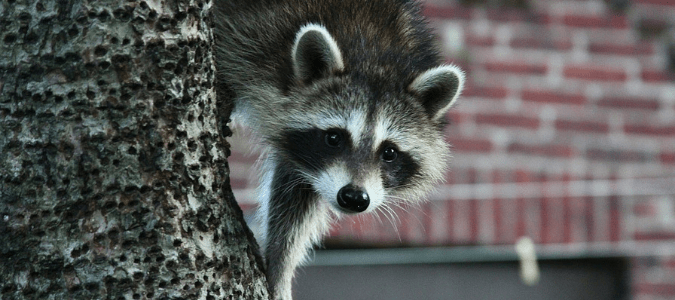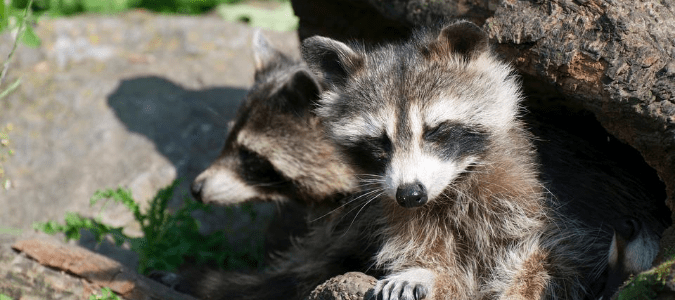
In response to your dog barking at something in the backyard, you turned on your patio lights to see a raccoon. This discovery brings many questions to the forefront of your mind, including whether or not a raccoon would attack you, your family members or your pets.
The good news is that, in many cases, raccoons will back off if confronted by a person or loud pets. However, this isn’t a guarantee. Sometimes raccoons can and will attack people, and this can be dangerous.
Generally speaking, raccoons attack in three situations:
- when they’re cornered,
- when they’re protecting their young and
- when they’re sick.
The first two situations both fall under the larger umbrella of protection because healthy raccoons only attack humans to protect themselves or their families. Otherwise, they’ll run.
Then, why do raccoons have a reputation for being menacing?
Raccoons behave in such a way that can be intimidating to get out of bad situations. However, the vast majority of the time they have no intention of standing their ground. Sometimes, they will dramatically lunge out in an offensive stance before turning tail and running. They do such a good acting job, though, that many people think a raccoon is going to attack them when all it really wants is to create a disturbance and an escape path.
If a raccoon is cornered or protecting her young, the situation may be different. The majority of attacks on humans by healthy raccoons occur when a person is trying to catch or tame the animal. Trying to trap a raccoon in a small space is likely to make these animals feel threatened, leaving them with no option but to scratch or bite. This is why it’s a better idea to contact a wildlife control professional if you need to remove raccoons from your property.
Pets can also trigger aggression in raccoons. A dog or cat chasing a raccoon can easily corner the animal and force it to turn on them instead. In fact, pets are attacked far more frequently than people because they are more likely to engage with raccoons.
It takes less to trigger a mother raccoon’s protective instincts. Just like most mother animals, they are fiercely protective of their offspring. Simply coming too close to her den can lead to a mother raccoon posturing aggressively and potentially attacking.
As we mentioned above, a raccoon may also attack you if it is sick. More specifically, raccoons with rabies can and will attack humans without being provoked. Raccoons are known as a rabies vector species for just that reason. The window for catching rabies from a raccoon is small, but it’s not unlikely. If you, a family member or a pet has been attacked by a raccoon, it’s wise to get medical attention just in case.
There are several signs that a raccoon is sick, or rabid. These signs include:
- staggering,
- not reacting to sudden loud noises,
- seeming aimless or wandering around,
- wet fur on its face,
- foaming at the mouth,
- strange, high-pitched noises and
- visible injuries.
Any one of these signs is a good reason to avoid a raccoon. Spotting a raccoon displaying more than one of those behaviors justifies a call to a wildlife control specialist.
Rabies makes animals actively aggressive, even in otherwise skittish species. It also leads to drooling, a lack of fear or pain responses and an inability to swallow. If you believe a raccoon (or any other animal) may be rabid, never try to approach that animal yourself. Rabies is fatal unless treated swiftly, so it’s best to leave wildlife control to the professionals.
Now you know what the signs are of a rabid raccoon and you should have a good idea in your mind of what a cornered raccoon looks like. However, it can be a bit more difficult to determine whether the raccoon is a mother that is protecting its young. To get a better understanding of the conditions under which this might happen, you’ll need to learn more about raccoon mating season. Next, we’ll explain when a raccoon may have babies and what steps you can take to keep pests away.

When Do Raccoons Mate?
Like most mammals, raccoons mate in the early spring. It takes two months for the mother to gestate, so kits are typically born in April or May. These young will remain near their mother for six to ten months, meaning a family unit will stay in one place for nearly a full year. One raccoon can have as many as four kits at a time, potentially leading to five raccoons living on your property at once.
Raccoons will leave their mother in the late fall to find their own homes and mates. At this point, they may travel as little as a block or two, or they may go miles away. However, the mother will remain nearby to produce her next litter.
Having even one raccoon living on your property can lead to significant amounts of damage in little time. Raccoons are notorious for invading trash cans for food and spreading their finds throughout the yard. They are omnivorous, so they will eat anything from leftover pizza in your trash to the vegetables and fruit in your garden, and could be the animal that is digging up your lawn at night.
Raccoons prefer to make dens in warm, dry, sheltered places. As a result, they are all too eager to make a home in unsealed attics, sheds or garages. They can even build dens in chimneys or under porches.
Once a raccoon has decided to make your home theirs, they will go about renovating it to suit their tastes. Raccoons will chew through siding to make entrance holes larger. They will bring bedding materials into their dens, leading to potential fire hazards. Some raccoons even pull up shingles to build their homes in your roof, leading to annoying tapping noises in your attic at night.
On top of the damage raccoons cause, it’s important to remember that they put you at risk of physical danger. Having a den of raccoons under your porch can quickly cause problems because the mother raccoon will protect her kits. Not exactly a harmonious cohabitation arrangement.

How to Keep Raccoons Away
Raccoons are intelligent and resourceful—great habits in a person, but quite unfortunate in a wild animal that has overstayed its welcome. Keeping a raccoon from going somewhere they want to go takes effort and thought. Unlike many other pest animals, they are curious and will sometimes cause trouble just to see what will happen. This is one reason why getting rid of raccoons often requires professional assistance.
The easiest way to remove raccoons from your property is to trap and release them elsewhere. However, properly trapping a raccoon requires specialized equipment and safety gear. Raccoons do not like being confined, so one of the most dangerous times to be around a raccoon is when it is being released in the wild. Wildlife control specialists have the knowledge and the equipment to safely capture raccoons and make your property less attractive to these unwelcome visitors.
If you’d prefer to handle the situation on your own, once you’re sure that you have no more raccoons around your home, you can work to keep them out. Removing sources of food and eliminating stagnant water is an effective way to do this.
Make trash cans difficult to open by securing the lids. You can use lid clamps, bungee cords or even just a heavy weight to keep your trash can lids from moving. If you have a compost pile, you should also remove it or move it to a sealed container. These are two of the most common food sources for raccoons who live near humans.
Next, remove water sources like birdbaths, pet dishes or other sources of standing water. Raccoons prefer to set up their den near a water source, so this will deter them from camping out on your property.
Finally, you need to seal or otherwise close off potential den sites from curious raccoons. Check your attic and seal any gaps or holes. You may need to spot-check your roof and repair loose shingles or soffits, too. To keep raccoons off your roof in the first place, trim back tree branches that hang over or near your roof.
Another important step is to put mesh over your vents and chimney. This will keep a variety of pest animals from entering your home, not just raccoons. Just make sure that the mesh is tightly secured and unable to be tugged off.
You can also put mesh or chicken wire around the bottom of raised porches, sheds or other outdoor structures. If you have an outdoor woodpile, it is helpful to remove it or move it into a shelter. Any covered, protected area is a potential den site.
Another benefit of taking these steps is that it can help with other types of pest control, in addition to making your property less attractive to raccoons. However, remember that raccoons are extremely curious animals. If any raccoons live elsewhere in your neighborhood, they may check out your yard on occasion. If there is a local population, seeing a raccoon occasionally is unavoidable. What you can avoid, though, is making them a permanent fixture on your property.
ABC Can Remove Unwanted Creatures from Your Property
Having a raccoon or even multiple raccoons living on your property can make for a difficult living situation. When you contact ABC Home & Commercial Services, we can send one of our pros to your property to trap and remove all raccoons living on your property so you don’t have to deal with these creatures. Afterward, we can leave you with suggestions on how to make your property less appealing to these creatures, as well as how to control common household and yard pests in the future.